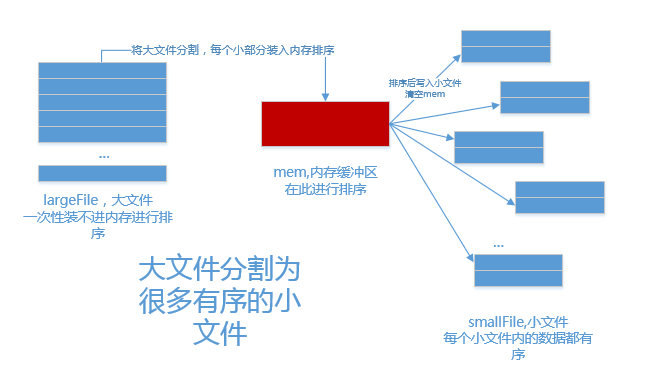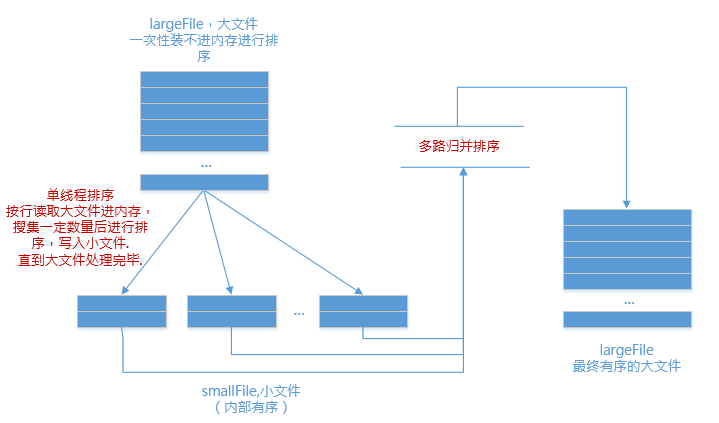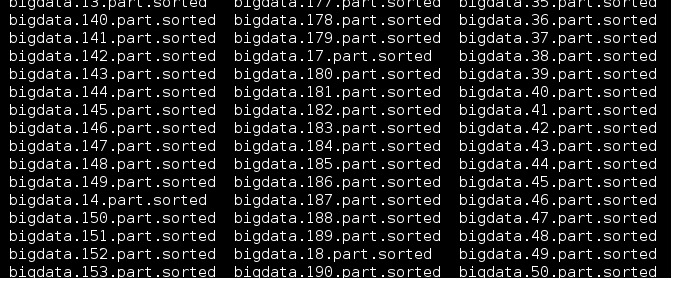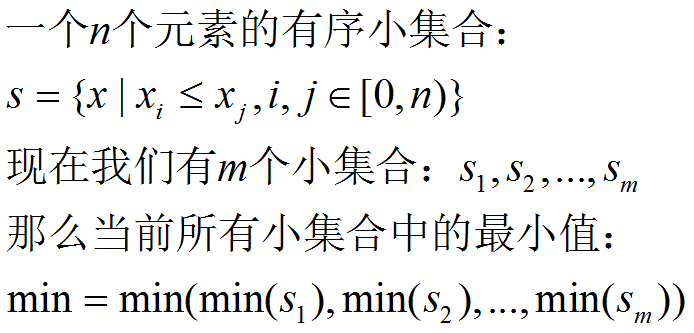http://www.importnew.com/23450.html?utm_source=tuicool&utm_medium=referral
问题
给你1个文件bigdata,大小4663M,5亿个数,文件中的数据随机,如下一行一个整数:
|
1
2
3
4
5
6
7
8
9
10
11
12
13
|
6196302
3557681
6121580
2039345
2095006
1746773
7934312
2016371
7123302
8790171
2966901
...
7005375
|
现在要对这个文件进行排序,怎么搞?
内部排序
先尝试内排,选2种排序方式:
3路快排:
|
1
2
3
4
5
6
7
8
9
10
11
12
13
14
15
16
17
18
19
20
21
22
23
24
25
26
27
28
29
30
31
32
33
34
35
36
37
38
39
40
41
42
43
44
45
46
47
48
49
50
51
52
53
54
55
56
57
58
59
60
61
62
63
64
65
66
67
68
69
70
71
72
73
74
75
76
77
78
79
80
81
82
|
private
final
int
cutoff =
8
;
public
<T>
void
perform(Comparable<T>[] a) {
perform(a,
0
,a.length -
1
);
}
private
<T>
int
median3(Comparable<T>[] a,
int
x,
int
y,
int
z) {
if
(lessThan(a[x],a[y])) {
if
(lessThan(a[y],a[z])) {
return
y;
}
else
if
(lessThan(a[x],a[z])) {
return
z;
}
else
{
return
x;
}
}
else
{
if
(lessThan(a[z],a[y])){
return
y;
}
else
if
(lessThan(a[z],a[x])) {
return
z;
}
else
{
return
x;
}
}
}
private
<T>
void
perform(Comparable<T>[] a,
int
low,
int
high) {
int
n = high - low +
1
;
//当序列非常小,用插入排序
if
(n <= cutoff) {
InsertionSort insertionSort = SortFactory.createInsertionSort();
insertionSort.perform(a,low,high);
//当序列中小时,使用median3
}
else
if
(n <=
100
) {
int
m = median3(a,low,low + (n >>>
1
),high);
exchange(a,m,low);
//当序列比较大时,使用ninther
}
else
{
int
gap = n >>>
3
;
int
m = low + (n >>>
1
);
int
m1 = median3(a,low,low + gap,low + (gap <<
1
));
int
m2 = median3(a,m - gap,m,m + gap);
int
m3 = median3(a,high - (gap <<
1
),high - gap,high);
int
ninther = median3(a,m1,m2,m3);
exchange(a,ninther,low);
}
if
(high <= low)
return
;
//lessThan
int
lt = low;
//greaterThan
int
gt = high;
//中心点
Comparable<T> pivot = a[low];
int
i = low +
1
;
/*
* 不变式:
* a[low..lt-1] 小于pivot -> 前部(first)
* a[lt..i-1] 等于 pivot -> 中部(middle)
* a[gt+1..n-1] 大于 pivot -> 后部(final)
*
* a[i..gt] 待考察区域
*/
while
(i <= gt) {
if
(lessThan(a[i],pivot)) {
//i-> ,lt ->
exchange(a,lt++,i++);
}
else
if
(lessThan(pivot,a[i])) {
exchange(a,i,gt--);
}
else
{
i++;
}
}
// a[low..lt-1] < v = a[lt..gt] < a[gt+1..high].
perform(a,low,lt -
1
);
perform(a,gt +
1
,high);
}
|
归并排序:
|
1
2
3
4
5
6
7
8
9
10
11
12
13
14
15
16
17
18
19
20
21
22
23
24
25
26
27
28
29
30
31
32
33
34
35
36
37
38
39
40
41
42
43
44
45
46
47
48
49
|
/**
* 小于等于这个值的时候,交给插入排序
*/
private
final
int
cutoff =
8
;
/**
* 对给定的元素序列进行排序
*
* @param a 给定元素序列
*/
@Override
public
<T>
void
perform(Comparable<T>[] a) {
Comparable<T>[] b = a.clone();
perform(b, a,
0
, a.length -
1
);
}
private
<T>
void
perform(Comparable<T>[] src,Comparable<T>[] dest,
int
low,
int
high) {
if
(low >= high)
return
;
//小于等于cutoff的时候,交给插入排序
if
(high - low <= cutoff) {
SortFactory.createInsertionSort().perform(dest,low,high);
return
;
}
int
mid = low + ((high - low) >>>
1
);
perform(dest,src,low,mid);
perform(dest,src,mid +
1
,high);
//考虑局部有序 src[mid] <= src[mid+1]
if
(lessThanOrEqual(src[mid],src[mid+
1
])) {
System.arraycopy(src,low,dest,low,high - low +
1
);
}
//src[low .. mid] + src[mid+1 .. high] -> dest[low .. high]
merge(src,dest,low,mid,high);
}
private
<T>
void
merge(Comparable<T>[] src,Comparable<T>[] dest,
int
low,
int
mid,
int
high) {
for
(
int
i = low,v = low,w = mid +
1
; i <= high; i++) {
if
(w > high || v <= mid && lessThanOrEqual(src[v],src[w])) {
dest[i] = src[v++];
}
else
{
dest[i] = src[w++];
}
}
}
|
数据太多,递归太深 ->栈溢出?加大Xss?
数据太多,数组太长 -> OOM?加大Xmx?
耐心不足,没跑出来.而且要将这么大的文件读入内存,在堆中维护这么大个数据量,还有内排中不断的拷贝,对栈和堆都是很大的压力,不具备通用性。
sort命令来跑
|
1
|
sort
-n bigdata -o bigdata.sorted
|
跑了多久呢?24分钟.
为什么这么慢?
粗略的看下我们的资源:
扫描二维码关注公众号,回复: 69487 查看本文章
- 内存
jvm-heap/stack,native-heap/stack,page-cache,block-buffer- 外存
swap + 磁盘数据量很大,函数调用很多,系统调用很多,内核/用户缓冲区拷贝很多,脏页回写很多,io-wait很高,io很繁忙,堆栈数据不断交换至swap,线程切换很多,每个环节的锁也很多.
总之,内存吃紧,问磁盘要空间,脏数据持久化过多导致cache频繁失效,引发大量回写,回写线程高,导致cpu大量时间用于上下文切换,一切,都很糟糕,所以24分钟不细看了,无法忍受.
位图法
|
1
2
3
4
5
6
7
8
9
10
11
12
13
14
15
16
17
18
19
20
21
22
23
24
25
26
27
28
29
30
31
32
33
34
35
36
37
38
39
40
41
42
43
44
45
46
47
48
49
50
51
52
53
54
55
56
57
58
59
60
61
62
63
64
|
private
BitSet bits;
public
void
perform(
String largeFileName,
int
total,
String destLargeFileName,
Castor<Integer> castor,
int
readerBufferSize,
int
writerBufferSize,
boolean
asc)
throws
IOException {
System.out.println(
"BitmapSort Started."
);
long
start = System.currentTimeMillis();
bits =
new
BitSet(total);
InputPart<Integer> largeIn = PartFactory.createCharBufferedInputPart(largeFileName, readerBufferSize);
OutputPart<Integer> largeOut = PartFactory.createCharBufferedOutputPart(destLargeFileName, writerBufferSize);
largeOut.delete();
Integer data;
int
off =
0
;
try
{
while
(
true
) {
data = largeIn.read();
if
(data ==
null
)
break
;
int
v = data;
set(v);
off++;
}
largeIn.close();
int
size = bits.size();
System.out.println(String.format(
"lines : %d ,bits : %d"
, off, size));
if
(asc) {
for
(
int
i =
0
; i < size; i++) {
if
(get(i)) {
largeOut.write(i);
}
}
}
else
{
for
(
int
i = size -
1
; i >=
0
; i--) {
if
(get(i)) {
largeOut.write(i);
}
}
}
largeOut.close();
long
stop = System.currentTimeMillis();
long
elapsed = stop - start;
System.out.println(String.format(
"BitmapSort Completed.elapsed : %dms"
,elapsed));
}
finally
{
largeIn.close();
largeOut.close();
}
}
private
void
set(
int
i) {
bits.set(i);
}
private
boolean
get(
int
v) {
return
bits.get(v);
}
|
nice!跑了190秒,3分来钟.
以核心内存4663M/32大小的空间跑出这么个结果,而且大量时间在用于I/O,不错.
问题是,如果这个时候突然内存条坏了1、2根,或者只有极少的内存空间怎么搞?
外部排序
该外部排序上场了.
外部排序干嘛的?
- 内存极少的情况下,利用分治策略,利用外存保存中间结果,再用多路归并来排序;
- map-reduce的嫡系.
1.分
内存中维护一个极小的核心缓冲区memBuffer,将大文件bigdata按行读入,搜集到memBuffer满或者大文件读完时,对memBuffer中的数据调用内排进行排序,排序后将有序结果写入磁盘文件bigdata.xxx.part.sorted.
循环利用memBuffer直到大文件处理完毕,得到n个有序的磁盘文件:
2.合
现在有了n个有序的小文件,怎么合并成1个有序的大文件?
把所有小文件读入内存,然后内排?
(⊙o⊙)…
no!
利用如下原理进行归并排序:
我们举个简单的例子:
文件1:3,6,9
文件2:2,4,8
文件3:1,5,7第一回合:
文件1的最小值:3 , 排在文件1的第1行
文件2的最小值:2,排在文件2的第1行
文件3的最小值:1,排在文件3的第1行
那么,这3个文件中的最小值是:min(1,2,3) = 1
也就是说,最终大文件的当前最小值,是文件1、2、3的当前最小值的最小值,绕么?
上面拿出了最小值1,写入大文件.
第二回合:
文件1的最小值:3 , 排在文件1的第1行
文件2的最小值:2,排在文件2的第1行
文件3的最小值:5,排在文件3的第2行
那么,这3个文件中的最小值是:min(5,2,3) = 2
将2写入大文件.也就是说,最小值属于哪个文件,那么就从哪个文件当中取下一行数据.(因为小文件内部有序,下一行数据代表了它当前的最小值)
最终的时间,跑了771秒,13分钟左右.
|
1
2
3
4
5
6
7
8
9
10
11
12
13
14
15
16
|
less bigdata.sorted.text
...
9999966
9999967
9999968
9999969
9999970
9999971
9999972
9999973
9999974
9999975
9999976
9999977
9999978
...
|



